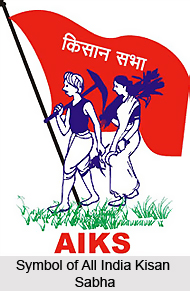 The All India Kisan Sabha (AIKS), also known as the Akhil Bharatiya Kisan Sabha and All India Peasants Union, was an Indian political association of the peasants front of the former undivided Communist Party of India (CPI). The All India Kisan Sabha was one of the Indian Organisations during Freedom Struggle and peasant movement that was founded by Swami Sahajanand Saraswati in the year 1936. The organisation was later divided into 2 different parts. The Kisan Sabha movement commenced in the state of Bihar, led by Swami Sahajanand Saraswati, who had established the Bihar Provincial Kisan Sabha (BPKS) in the year 1929 in order to assemble and organize peasant grievances against the assaults of the zamindars on their occupancy rights. This sparked the Farmers` movement in the nation.
The All India Kisan Sabha (AIKS), also known as the Akhil Bharatiya Kisan Sabha and All India Peasants Union, was an Indian political association of the peasants front of the former undivided Communist Party of India (CPI). The All India Kisan Sabha was one of the Indian Organisations during Freedom Struggle and peasant movement that was founded by Swami Sahajanand Saraswati in the year 1936. The organisation was later divided into 2 different parts. The Kisan Sabha movement commenced in the state of Bihar, led by Swami Sahajanand Saraswati, who had established the Bihar Provincial Kisan Sabha (BPKS) in the year 1929 in order to assemble and organize peasant grievances against the assaults of the zamindars on their occupancy rights. This sparked the Farmers` movement in the nation.
In the year 1935, renowned peasant leaders like E.M.S. Namboodiripad and N.G. Ranga, who served as the joint secretary and secretary respectively of South Indian Federation of Peasants and Agricultural Labour, recommended the establishment of an all India farmers association. Eventually on 11th April 1936, the All India Kisan Sabha (AIKS) was formed at the session of the Indian National Congress Party held at Lucknow. Swami Sahajanand Saraswati was appointed as the first President of the organistaion. Moreover the All India Kisan Sabha or Akhil Bharatiya Kisan Sabha also included other well known political leaders, namely Bankim Mukerji, Acharya Narendra Deva, Jayaprakash Narayan, Ram Manohar Lohia, P. Sundarayya, Rahul Sankrityayan, Pandit Jadunandan (Yadunandan) Sharma, Pandit Yamuna Karjee, Pandit Karyanand Sharma, E.M.S. Namboodiripad and N.G. Ranga.
In August 1936, the Kisan Manifesto was released, which demanded the elimination of zamindari system and annulment of rural debts. The Sabha adopted the red flag as a banner in October 1937. In the following years, the peasant movement was progressively dominated by Communists and Socialists as the association distanced itself from the Indian National Congress Party. The split became apparent at the Haripura session of the Indian National Congress in the year 1938, under the leadership of Netaji Subhash Chandra Bose. The Communist Party of India had taken control of the All India Kisan Sabha throughout the nation by May 1942.
In the year 1964, the Communist Party of India (CPI) was divided into 2 separate units and as a result the All India Kisan Sabha (Akhil Bharatiya Kisan Sabha) was also divided accordingly. At present there are 2 separate organizations that operate with the name of All India Kisan Sabha-
* All India Kisan Sabha (Ajoy Bhawan), which is associated with the Communist Party of India
* All India Kisan Sabha (Ashoka Road), which is associated with the Communist Party of India (Marxist)




















